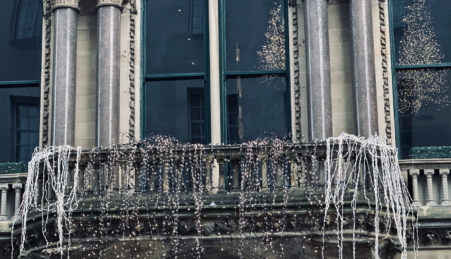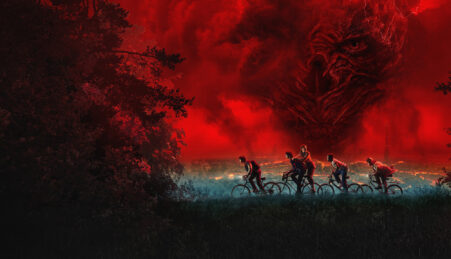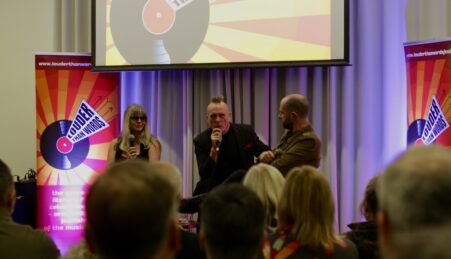By Humanity Hallows
The Lost Boys of WWI exhibition, part of the Humanities in Public Festival’s ‘WAR’ strand, was unveiled at Manchester Metropolitan University (MMU) this week.
Johnny Magee, one of the three artists working on the project, told Humanity Hallows: “For me, the exhibition is more about acknowledgement than remembrance.”
It’s an acknowledgement of the humanity within war, and that, I think, is why it is expressed predominantly through children – those innocent, and undeserving of man’s horror.
![DSC_0284[1]](http://www.humanityhallows.co.uk/wp-content/uploads/2015/11/DSC_02841-1024x681.jpg) Magee’s work is striking. Bent in neon along the pitch-white walls of MMU’s Holden gallery are the words: ‘THEY’LL NEVER BELIEVE ME!’ a play on a song from 1913 musical, They Didn’t Believe Me, which was adapted by soldiers to satirise the impression that people at home had of their trench-lives.
Magee’s work is striking. Bent in neon along the pitch-white walls of MMU’s Holden gallery are the words: ‘THEY’LL NEVER BELIEVE ME!’ a play on a song from 1913 musical, They Didn’t Believe Me, which was adapted by soldiers to satirise the impression that people at home had of their trench-lives.
The pieces juxtapose the abrasive lights of the new world with the fading documents of the old, separating them as the words themselves might separate a returning soldier from his family. Its exclamation mark, and its playful design, put the focus on the sense of camaraderie that existed between men in the war, within which lies great humanity.
The centrepiece of the exhibition, in which twenty-two ceramic Subbuteo players line up, belongs to curator Stephen Dixon. In this piece, in which the scene of the Christmas Day Truce has been recreated, Dixon uses the children’s game to place the focus on the individuals involved in the match. On each figure is inscribed the name of a man who wrote of having played The Beautiful Game on the Western Front: just one example of the tireless – and endearing – research that is embedded throughout the collection.
![DSC_0280[1]](http://www.humanityhallows.co.uk/wp-content/uploads/2015/11/DSC_02801-1024x681.jpg) In 2015, when the names on the walls of the cenotaphs are more symbolic than particular, Dixon successfully emphasises the specific. Private Mackal, of the 134th Saxon Regiment, stands between the posts for the Germans. He, who had been an unknown legend, is again a man. A man who wasn’t born with a gun in his hands, a man who wanted to play football with his friends, a man with humanity.
In 2015, when the names on the walls of the cenotaphs are more symbolic than particular, Dixon successfully emphasises the specific. Private Mackal, of the 134th Saxon Regiment, stands between the posts for the Germans. He, who had been an unknown legend, is again a man. A man who wasn’t born with a gun in his hands, a man who wanted to play football with his friends, a man with humanity.
“It has a reverential quality to it,” Dixon says. “It’s not ‘anti-war’, which is a difficult thing to remain true to.”
At times, however, it seems that the exhibition can’t help but slide towards being just that, but still, the key here is putting identity – people – back into our collective war narratives.
Continuing the theme, Alison Welsh’s Flowers of the Field, is a Pattern Service Dress tunic – one of the most recognisable items of clothing in our history, on the torso of a mannequin. Welsh’s grandfather was only fifteen when he joined the war. He went to play the bagpipes and came back with one arm.
Her piece stands, limbless, in the corner. Its solitude a sad salute to the loneliness of the small boys dressed as men, torn from their homes, and their mothers. Through the button-holes, Welsh, who is a textiles specialist, sews white flowers. Here, perhaps, is that ‘anti-war’ sentiment? It’s more than that – taking the red out of the poppy strips it of the jingoistic idea of heroism. Again, it takes the legend, and it makes it human: a pale boy, standing alone in an empty playground, burdened by the murder of his friends.
There is far more in this exhibition that is worthy of discussion. In Johnny Magee’s recoloured photographs, sent home by both sides as postcards to worried families and loved ones, he sets parallels between the humanity of the Germans and the Allies. It’s simple, but it tells such a story.
In the stories of the audience, too, stimulated by forgotten figurines and photographs, there are great images of life as we know it, reminding us – if not directing us – not to skim over the pain and emotion of the past.
The Lost Boys of WW1 revisits turf trodden down with the boots of a hundred years, and still its angle is refreshing. It asks that you put yourself in the stories, in the postcards, on the football pitch, in the jacket. Most of all, it helps you to feel the humanity of the war: the humour, the loss and the love.
Further FREE events for The Lost Boys exhibition are listed on the events page.

![DSC_0284[1]](http://www.humanityhallows.co.uk/wp-content/uploads/2015/11/DSC_02841-1024x681.jpg)
![DSC_0280[1]](http://www.humanityhallows.co.uk/wp-content/uploads/2015/11/DSC_02801-1024x681.jpg)




Leave a reply